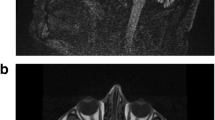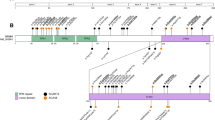Abstract
The phenotypes of patients with disease-associated variants in DNMT1 have been classified into two syndromes: hereditary sensory and autonomic neuropathy type 1E (HSAN1E, MIM614116, https://www.omim.org/) and autosomal dominant cerebellar ataxia, deafness, and narcolepsy (ADCA-DN, MIM604121). The amino acid codon 511 is a hotspot, and p.Y511C is the most frequently observed disease-associated variant among those in HSAN1E patients, whereas there have been only a few reports on patients with p.Y511H. In this study, we report on the cases of a kindred carrying the DNMT1 variant NM_001130823.2:c.1531 T > C (p.Y511H) presenting with the ADCA-DN phenotype. The review of the literature further revealed that later ages at onset and the presence of cerebellar ataxia are the main characteristics of patients carrying the DNMT1 p.Y511H as compared with those carrying DNMT1 p.Y511C. Although HSAN1E and ADCA-DN are proposed to be called DNMT1-complex disorders owing to their overlapping symptoms, this finding suggests a distinct genotype–phenotype correlation regarding the DNMT1 p.Y511H and p.Y511C variants.


Similar content being viewed by others
Abbreviations
- MMSE:
-
Mini-Mental State Examination
- WAIS:
-
Wechsler Adult Intelligence Scale
- VIQ:
-
Verbal Intelligence Quotient
- PIQ:
-
Performance Intelligence Quotient
- FIQ:
-
Full-Scale Intelligence Quotient
References
Baets J, Duan X, Wu Y, Smith G, Seeley WW, Mademan I et al (2015) Defects of mutant DNMT1 are linked to a spectrum of neurological disorders. Brain 138(4):845–861
Billiard M (2007) Diagnosis of narcolepsy and idiopathic hypersomnia. An update based on the International classification of sleep disorders, 2nd edition. Sleep Med Rev 11(5):377–388
Hojo K, Imamura T, Takanashi M, Ishii K, Sasaki M, Imura S et al (1999) Hereditary sensory neuropathy with deafness and dementia: a clinical and neuroimaging study. Eur J Neurol 6(3):357–361
Klein CJ, Botuyan MV, Wu Y, Ward CJ, Nicholson GA, Hammans S et al (2011) Mutations in DNMT1 cause hereditary sensory neuropathy with dementia and hearing loss. Nat Genet 43(6):595–600
Klein CJ, Bird T, Ertekin-Taner N, Lincoln S, Hjorth R, Wu Y et al (2013) DNMT1 mutation hot spot causes varied phenotypes of HSAN1 with dementia and hearing loss. Neurology 80(9):824–828
Melberg A, Hetta J, Dahl N, Nennesmo I, Bengtsson M, Wibom R et al (1995) Autosomal dominant cerebellar ataxia deafness and narcolepsy. J Neurol Sci 134(1–2):119–129
Moghadam KK, Pizza F, La Morgia C, Franceschini C, Tonon C, Lodi R et al (2014) Narcolepsy is a common phenotype in HSAN IE and ADCA-DN. Brain 137(6):1643–1655
Watanabe M, Matsumoto Y, Okamoto K, Okuda B, Mizuta I, Mizuno T (2017) A case of hereditary sensory and autonomic neuropathy type 1E with frontal lobe dysfunction as an initial symptom. Rinsho Shinkeigaku 57(12):753–758
Winkelmann J, Lin L, Schormair B, Kornum BR, Faraco J, Plazzi G et al (2012) Mutations in DNMT1 cause autosomal dominant cerebellar ataxia, deafness and narcolepsy. Hum Mol Genet 21(10):2205–2210
Wright A, Dyck PJ (1995) Hereditary sensory neuropathy with sensorineural deafness and early-onset dementia. Neurology 45(3):560–562
Acknowledgments
We thank the family members for participating in this study. We also thank the doctors who collected and provided clinical information of the patients.
Funding
This work was supported in part by Grants-in-Aid [H23-Jitsuyoka (Nanbyo)-Ippan-004 and H26-Jitsuyoka (Nanbyo)-Ippan-080] from the Ministry of Health, Labour and Welfare, Japan, and grants (16kk0205001h0003, 18ek0109279h0002, and 19ek0109279h0003) from the Japan Agency for Medical Research and development, AMED.
Author information
Authors and Affiliations
Corresponding author
Ethics declarations
Conflict of Interest
The authors declare that they have no conflict of interest.
Ethics Approval
The study was approved by the institutional review board of the University of Tokyo.
Informed Consent
The study was approved by the institutional review board of the University of Tokyo. Written informed consent was obtained from the proband.
Consent to Participate
Written informed consent was obtained from the proband.
Consent to Publication
Written informed consent was obtained from the proband.
Additional information
Publisher’s Note
Springer Nature remains neutral with regard to jurisdictional claims in published maps and institutional affiliations.
Rights and permissions
About this article
Cite this article
Kikuchi, J.K., Nagashima, Y., Mano, T. et al. Cerebellar Ataxia as a Common Clinical Presentation Associated with DNMT1 p.Y511H and a Review of the Literature. J Mol Neurosci 71, 1796–1801 (2021). https://doi.org/10.1007/s12031-020-01784-5
Received:
Accepted:
Published:
Issue Date:
DOI: https://doi.org/10.1007/s12031-020-01784-5




